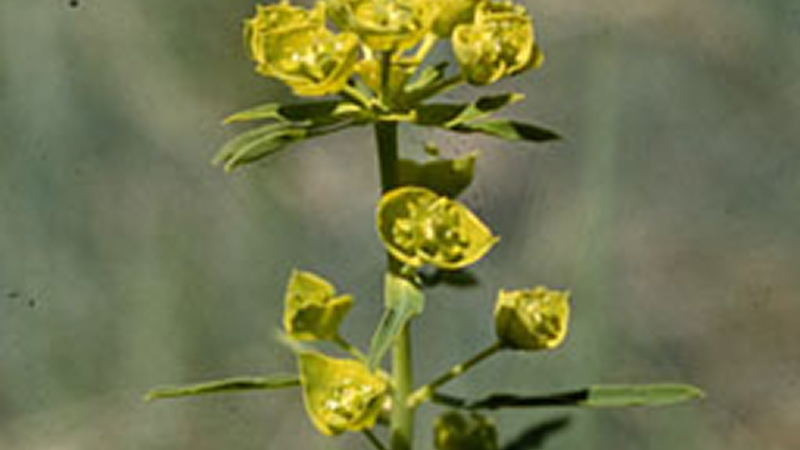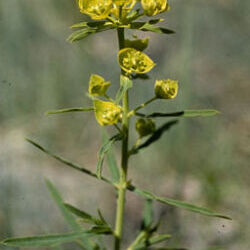
Priority: Eradicate
General: A plant with yellow-green flowers clustered in an umbrella shape.
Height: It grows between 20-90cm tall.
Flowers: Flowers are greenish yellow in a cluster at the top of the plant in a flat topped umbrella shape. The flowers have heart shaped floral leaves under the clusters. The flowers are on long stalks.
Leaves/Stems: Stems are branched near the top. Leaves and stems are a pale, bluish-green colour. Leaves are attached to the stem in a spiral, alternating pattern. The leaves are narrow and lance shaped, 2.5-10 cm long and 6mm wide. Leaves and stems exude a milky sap when broken or cut.
Root: Extensive creeping root systems that can grow to a depth of 7.6m
Wolf’s milk, Leafy Euphorbia
Lemonweed (Lithospermum ruderale)
Differences: Lemonweed is different from Leafy spurge because it has stiff hairs on its foliage. The flowers are yellow but tubular in shape with 5 spreading lobes.
Where did it come from? Introduced from Eurasia.
Where does it grow here? Leafy spurge is well adapted to a variety of environments but prefers semi-arid areas. Found in low to mid elevations in BC on dry roadsides, fields, grasslands, open forests and disturbed habitat.
Reproduction: Grows from seed and extensive root system. Root fragments can also create a new plant.
When does it grow, flower & seed? Sprouts April-May. Flowers June-August. Seeds September.
Spreads By: The seeds are propelled from the plant by capsules that burst open when ripe.
Plant Type: Perennial.
- Toxic plant due to the milky sap contained in stem and leaves. ALWAYS wear gloves if handling or removing. It can cause skin rashes, blisters and swelling.
- Toxic to cattle. It causes irritation to mouth and digestive track.
- Invades rangelands and decreases forage for both wildlife and livestock.
- Aggressively spreads because of the buds on the long and deep creeping root system.
- Review your property regularly for this species.
- Treatment Remove small patches before it flowers & sets seed. WEAR GLOVES and remove the entire plant including the roots. Any manual treatment including hand-pulling, digging or tilling is very unlikely to eradicate this species because of the extensive root system.
- Cover bare patches or disturbed soil by planting or seeding with non-invasives.
- Check areas where you have removed invasives for any new plants that year and in future growing seasons.
- Dispose of invasive plants responsibly. Bag them for disposal at the local landfill. Composting and burning is not recommended.
Contact LRISS for specific treatment recommendations. This species does have biocontrol agents that have had success on infestations in some areas of BC.
Okanagan Invasive Species Online website
Southern Interior Weed Management Committee. 2016. Invasive Plants of the Southern Interior BC. 86pgs.
E-Flora BC: Electronic Atlas of the Flora of British Columbia
